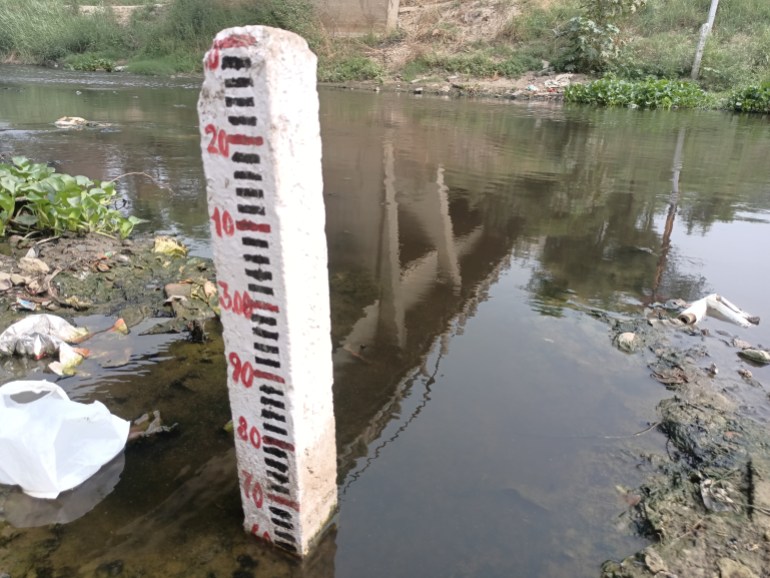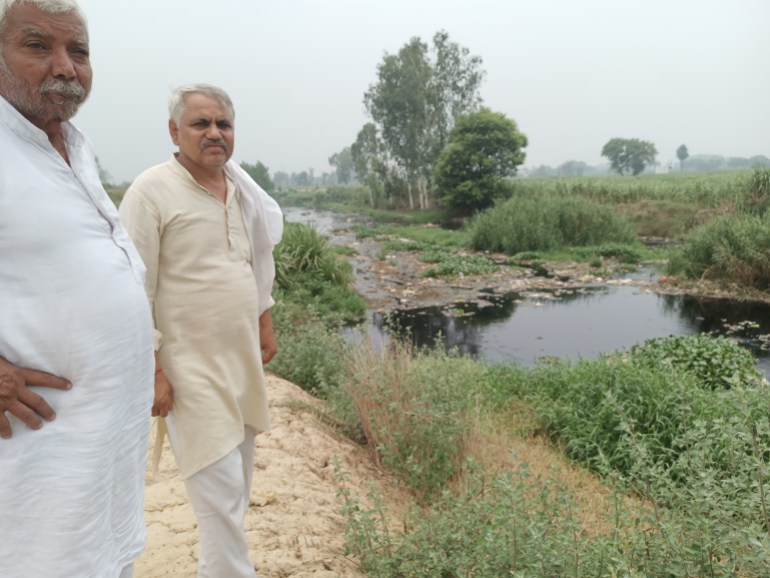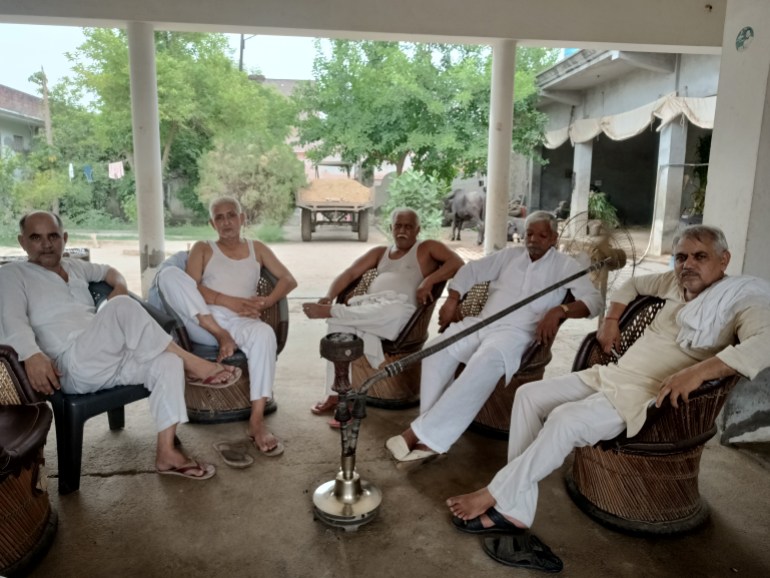How river pollution is killing people in an Indian village | News
Gangnauli, India – Vikas Rathi lies, barely alive, on a cot in the sparsely furnished living room of a small two-story house in Gangnauli village in the northern state of Uttar Pradesh. The 23-year-old’s gaunt cheeks highlight his pinched nose and sunken eyes even more.
Vikas has been diagnosed with stunted growth and bone deformity. He is one of the hundreds of young adults and adolescents across the region who are afflicted by a host of ailments: stunted growth, liver diseases, cancers, and critical deformities.
In Gangnauli – home to about 5,000 people and located about 180km (110 miles) from India’s capital New Delhi – about a third of the youth are sick.
Villagers say the diseases are striking more and more people, affecting almost every household. The contaminated groundwater they have been drinking, they say, is destroying their health.
More than 71 people died of cancer in Gangnauli alone between 2013 and 2018, according to data released by the National Green Tribunal (NGT) in 2019, the only official figure available.
Satendar Rathi, Vikas’ father, says his eldest son Vikas, whose name means growth in the Hindi language, has been bedridden since 2010
He was born healthy, his father continues, but his bones started deforming soon after he started drinking and eating solid food.
“We took him for traditional as well as English [modern] medicine treatment. Doctors suggested vitamin D supplements. We continued his treatment for nine years but nothing worked,” Satendar, a 48-year-old constable in the Delhi police, says as he sinks into a chair in the living room on the banks of the Krishna River.
His modest salary of $490 a month can barely cover medical expenses for Vikas.
“Finally, the doctors in Delhi told us there is a problem with the water we were consuming,” Satendar told Al Jazeera, referring to the groundwater.
“We can’t leave him alone for even a minute. If there is no one around he urinates and passes stool in his pants,” says Satendar, sighing helplessly as Vikas looks hauntingly at us.
“Vikas is a living corpse,” he says.

Carcinogens in the water
The NGT – the country’s top environmental court – confirmed in 2017 that water was indeed the cause of the mass sickness in villages across five districts in western Uttar Pradesh after the crisis was brought to its attention by environmental campaigners and it tested the groundwater and river water.
In the villages that did not have a piped water supply, villagers were drinking polluted groundwater pulled up by hand pumps.
The NGT recommended a door-to-door medical survey across the 48 hardest-hit villages in the region. It also called for providing piped drinking water, the establishment of specialised hospitals, and curbs on industrial effluents, among other measures.
But the health department in the state – India’s most populous – has not followed through on most of the recommendations, Al Jazeera found.
Dr Dinesh Kumar, chief medical officer of Baghpat district, where Gangnauli is located, admitted that carcinogenic elements had been found in the water.
“It is true that heavy elements and carcinogenic elements are present in the water but we can’t say for sure that they are responsible for cancer in the area. I am saying this because further studies have not been done on the cases studies found here to explore the links between the two,” he told Al Jazeera.
He added that a survey had been conducted more recently as part of anti-COVID health measures, during which officials were directed to identify cancer patients and people with co-morbidities.
“We found cases of skin diseases. Cases of Hepatitis C are found higher than usual in these villages.”
Industrial pollution
The fertile soil of the upper Doab region – the river basin of the Ganges and Yamuna Rivers – was home to a substantial agricultural community. Water from the Kali, Krishna and Hindon Rivers – important tributaries of the Yamuna River to the west – used to be a source of life and livelihood in the region some 20 years ago.
But Doab’s proximity to the capital led to many of its cities, such as Meerut, Baghpat, Saharanpur, Gautam Buddh Nagar and Ghaziabad, becoming industrial centres.

Dharmendar Rathi, the former village head of Gangnauli, says the groundwater started becoming poisonous as industries and mills started proliferating in the area, operating without the waste-treatment facilities they are required to have.
The industrial waste from sugar mills, slaughterhouses, paper mills, dye-making industries and distilleries empties into the rivers, turning them into sewage canals. Eventually, the unchecked industrial waste dumping contaminated the groundwater.
Dharmendar says: “Most of us kept drinking it till the last few years, our cattle drank it, and we used it to irrigate our farm and vegetables.”
He tells Al Jazeera there isn’t a single household in the village without a critically ill family member and that more than 200 people in Gangnauli had to sell their land to pay for medical expenses.
Many families have gone bankrupt treating their sick members, running from one hospital to another due to a lack of adequate health facilities in the state of 204 million people, he says.
“Our estimate suggests that more than 150 in this village alone have died of cancer, there are numerous cases of hepatitis, skin allergies and deformities. Just imagine the number of victims in other affected villages in this region.
“The future of this region is gone, the next generation has been destroyed at birth,” he says, showing a long list of villagers who died of cancer in the last decade.
Appealing to the NGT
Chandraveer Singh, from the nearby village of Daha, says his sister-in-law Urmila died of liver cancer earlier this year.
According to the 65-year-old retired scientist, people in more than 100 villages on the banks of the Kali, Krishna and Hindon Rivers have been drinking polluted groundwater for the last decade.
After he retired in 2013, Chandraveer, who worked at the pollution control board in the neighbouring state of Haryana, started working on water pollution in western UP. He petitioned the NGT in 2014 to intervene on the issue.
In 2014, he sent water samples from the Krishna for testing at SIMA Labs. SIMA labs are recognised by the Federal Ministry of Environment and Forests, and the Uttar Pradesh Pollution Control Board (UPPCB).
The results were disturbing – they confirmed an extremely high content of heavy metals and chemical compounds like arsenic, mercury, lead, zinc, phosphate, sulfide, cadmium, iron, nickel and manganese. All heavy metals are linked with cancer, bone deformity, and stomach-related diseases.
The total suspended solids in the river water measured 7,500mg/litre, as against the permissible 200mg/litre. The presence of sulfide was 285mg/litre as against the permissible 2mg/litre.
Extremely high levels of mercury and lead were also found. Lead was 0.115 as against the permissible limits of 0.01 mg/litre. Mercury was 0.12 mg/litre against the permissible limits of 0.01 mg/litre.
“No aquatic life survives in the river water,” says Chandraveer.
State of health services
Dharmendar says the local community health centres lack resources.
“The public health centres in the vicinity are not equipped to deal with a problem of this magnitude. Only a nurse or the doctor’s assistant is generally present at the health centres,” he says.
The closest big hospital is in Meerut – the largest city in the region – about 56km (35 miles) east of Gangnauli.
“The government hospital in Meerut is overcrowded and patients do not get the care they deserve,” he says, adding that there are not enough doctors.

The state, currently being governed by Prime Minister Narendra Modi’s Bharatiya Janata Party (BJP), ranks at the bottom of the health index prepared by the NITI Aayog – the government policy think-tank.
But the health crisis has hardly made it to the political agenda in the state as successive governments ignored the health issues people face. “What is the meaning of democracy when my people are dying of unexplained sickness and death? For decades we drank toxic water,” Dharmendar says.
“How could we dream of becoming a vishwa guru [super power] when we can’t provide the basic facilities which are essential to our fundamental right to life?”
Local BJP legislator Krishan Pal Singh defended the government, blaming previous governments for doing nothing to address the issue.
“Whatever relief people have got on this subject, happened under the BJP government,” he told Al Jazeera. The BJP came back to power in UP in 2017 after a gap of 15 years.
“When we came to power, we were given a state which barely saw any development. So it might take some time to solve people’s problems,” he adds.
NGT recommendations
Four years since the country’s top environmental watchdog recommended measures, local authorities have only partially implemented them.
Most of the polluting industries, mainly sugar mills, distilleries, electroplating workshops and slaughterhouses, continue to dump effluent into the rivers with little or no facilities put in place to treat industrial waste.
The NGT formed a supervisory committee in 2018 to monitor the implementation of its recommendations. The committee in its four reports since 2019 said no meaningful action had been taken by authorities to clean up the Kali, Krishna and Hindon Rivers. It accused Uttar Pradesh officials of “apathy” and even “stonewalling” its action plan and monitoring.
In its last directive – released in February 2021 and seen by Al Jazeera – the NGT notes that officials “did not comply” with most of its recommendations. The state government has not cooperated and its attitude was “disappointing”, the NGT said.
Out of the total of 133 sewage drains that needed to be covered, only 20 were covered and the remaining 113 are “in the process of being tapped”, as the progress report submitted by the government mentions. The sewage drain tapping would help control the spread of diseases.
Some of the recommendations, such as the preparation of micro plans to prevent groundwater pollution by industrial effluents, and identify and deal with other sources of water pollution – covering the entire stretch of drains, and identifying causes of ailments like skin diseases, jaundice and cancer – were not complied with, according to the February 2021 NGT order.
The only work that has been done to some measure is providing piped drinking water to more than 50 percent of the residents in these 150-plus villages, the committee said.
Local health officials in Baghpat told Al Jazeera COVID-19 had prevented them from making any plans. Singh, the local BJP legislator, also blamed the pandemic for the delay in implementing the NGT recommendations.
The NGT had highlighted repeatedly how the UPPCB couldn’t finish work on its recommendations: bio/phytoremediation of drains (using plants and micro-organisms to clean industrial effluents), covering drains, installing sewage treatment plants in water-polluting industries.
A senior official from the UPPCB, who wished to remain anonymous, told Al Jazeera: “As we mentioned in our ‘action taken report’ submitted before the NGT, bioremediation work on several drains over a total stretch of 76km is being done. The bioremediation on drains in Shamli, Muzaffarnagar and Baghpat has been initiated.
“[W]ork on the installation of sewage treatment plants in Muzaffarnagar and Budhana will be done soon. Work on the one in Saharanpur will be started soon,” he said, adding, “it will take some time before the work is completed.”
“By law, the industries are supposed to have a sewage treatment plant (STP) installed before they operationalise the factory. But, courtesy of corruption, in most cases the industries bribe officials and start functioning without an STP which is supposed to treat the effluents. So the state government is penalising the industries now in a big way, and pushing them to have an STP in their factories,” he added.
He added that among the decisions the UPPCB has taken to mitigate pollution is the imposition of a fine of 11.32 crore rupees ($1.41m) as environmental compensation on 230 industries for polluting river water in the last four years.
Environmental campaigner Chandraveer isn’t hopeful.
“The institutional and bureaucratic dysfunction of the world’s largest democracy continues to deprive the remaining residents of safe and clean drinking water,” he tells Al Jazeera.
